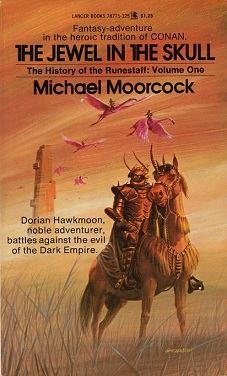
The Jewel in the Skull
Michael Moorcock
175 pages
published in 1967
The Jewel in the Skull is another of Michael Moorcock's seemingly endless number of fantasy series, the first in the History of the Runestaff quartet. It's also part of Moorcock's overarching Eternal Champion mythos, with the hero, Dorian Hawkmoon, being yet another reincarnation of the Eternal Champion. Not that this is important in this book, which can easily be read as a standalone adventure. A such it fair zips along, having been published at the tail end of the era when fantasy and science fiction books were considered long if they managed 150 pages.
It's also a very blokey book. There are only two female characters of note in it, one of which in the role of the hero's reward, the other a damsel in distress for the hero to rescue. If you don't notice or can live with that, the Jewel in the Skull is a clever, fun adventure story. It's set in a far future Europe, some thousands of years after the Tragic Millennium ended our own civilisation. Much of Europe now is under occupation By Granbretan, a tyrranical empire ruled by an immortal corrupt emperor, a tightly controlled, cruel and strictly hierarchical society. Dorian Hawkmoon, the duke of Köln was the last hero to resist their advance, rising up in rebellion against them, and failed. Now he's a prisoner in Londra, his fate to serve as entertainment for its rulers...
That's not where it starts though. It starts with count Brass, the ruler of the Kamarg (what remains of the present day Camargue. He's named Brass for the armour he wears. Once he was a fearsome warrior and adventurer; these days he's only interested in keeping his own country free. He's not interested in fighting against Granbretan as long as it leaves Kamarg in peace. But when he thwarts the designs of an Granbretan emissary, Baron Meliadus, he makes an enemy for life -- and Baron Meliadus will use Hawkmoon to bring him down.
The Jewel in the Skull is perhaps one of the most straightforward of Moorcock's fantay stories and as such one of his most accessible too. Even though the story at times borders on formulaic, Moorcock still brings his own touch to it, with the protagonist only making his first appearance some 44 pages into the story. Granbretan as well is fairly Moorcockian, the overtly ordered, insane and evil society still with a certain glamour, slightly reminiscent of the Melnibone of Elric.
In general, it's been interesting to see how deftly Moorcock can sketch out a whole world with just a few details, suggest a backstory with just a few hints. There is quite a bit of exposition in the story, but it never palls and it's done lightly, when needed, not just for the sake of "world building".
In the end this is still only a minor Moorcock, nowhere near as complex or fullfilling as his true masterpieces, a competent story told by a still young writer. Interesting, but not essential.
Webpage created 30-08-2012, last updated 06-09-2012.